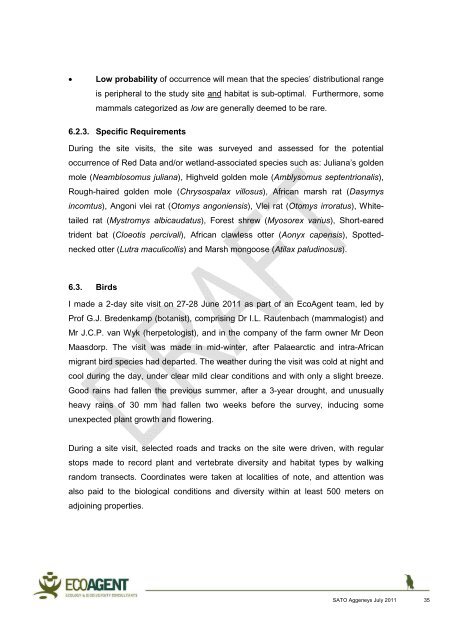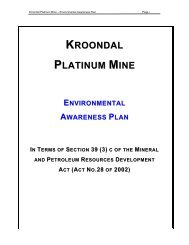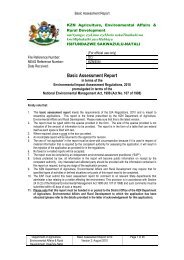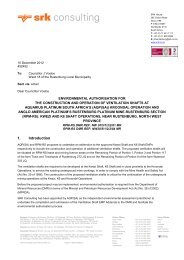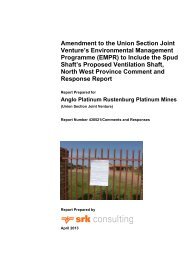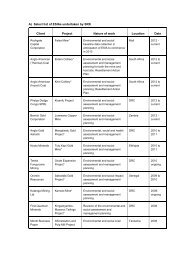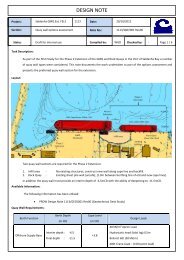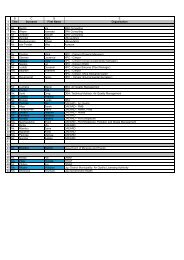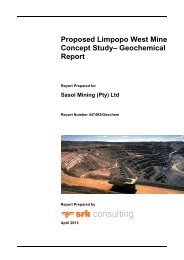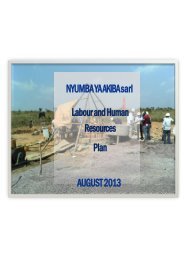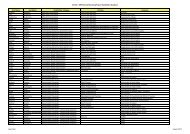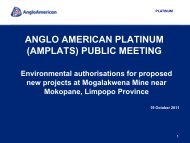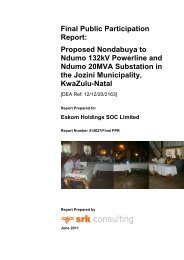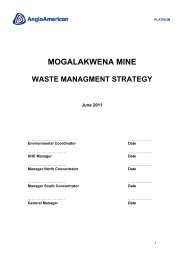Biodiversity (1 - SRK Consulting
Biodiversity (1 - SRK Consulting
Biodiversity (1 - SRK Consulting
You also want an ePaper? Increase the reach of your titles
YUMPU automatically turns print PDFs into web optimized ePapers that Google loves.
• Low probability of occurrence will mean that the species’ distributional range<br />
is peripheral to the study site and habitat is sub-optimal. Furthermore, some<br />
mammals categorized as low are generally deemed to be rare.<br />
6.2.3. Specific Requirements<br />
During the site visits, the site was surveyed and assessed for the potential<br />
occurrence of Red Data and/or wetland-associated species such as: Juliana’s golden<br />
mole (Neamblosomus juliana), Highveld golden mole (Amblysomus septentrionalis),<br />
Rough-haired golden mole (Chrysospalax villosus), African marsh rat (Dasymys<br />
incomtus), Angoni vlei rat (Otomys angoniensis), Vlei rat (Otomys irroratus), Whitetailed<br />
rat (Mystromys albicaudatus), Forest shrew (Myosorex varius), Short-eared<br />
trident bat (Cloeotis percivali), African clawless otter (Aonyx capensis), Spottednecked<br />
otter (Lutra maculicollis) and Marsh mongoose (Atilax paludinosus).<br />
6.3. Birds<br />
I made a 2-day site visit on 27-28 June 2011 as part of an EcoAgent team, led by<br />
Prof G.J. Bredenkamp (botanist), comprising Dr I.L. Rautenbach (mammalogist) and<br />
Mr J.C.P. van Wyk (herpetologist), and in the company of the farm owner Mr Deon<br />
Maasdorp. The visit was made in mid-winter, after Palaearctic and intra-African<br />
migrant bird species had departed. The weather during the visit was cold at night and<br />
cool during the day, under clear mild clear conditions and with only a slight breeze.<br />
Good rains had fallen the previous summer, after a 3-year drought, and unusually<br />
heavy rains of 30 mm had fallen two weeks before the survey, inducing some<br />
unexpected plant growth and flowering.<br />
During a site visit, selected roads and tracks on the site were driven, with regular<br />
stops made to record plant and vertebrate diversity and habitat types by walking<br />
random transects. Coordinates were taken at localities of note, and attention was<br />
also paid to the biological conditions and diversity within at least 500 meters on<br />
adjoining properties.<br />
SATO Aggeneys July 2011 35


